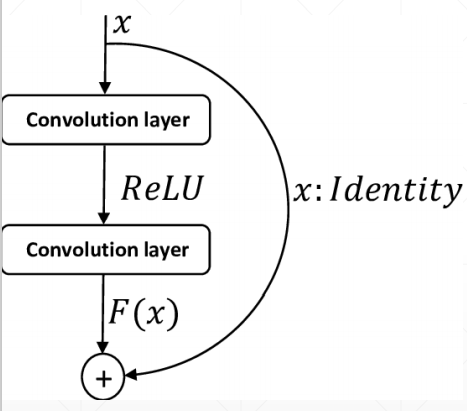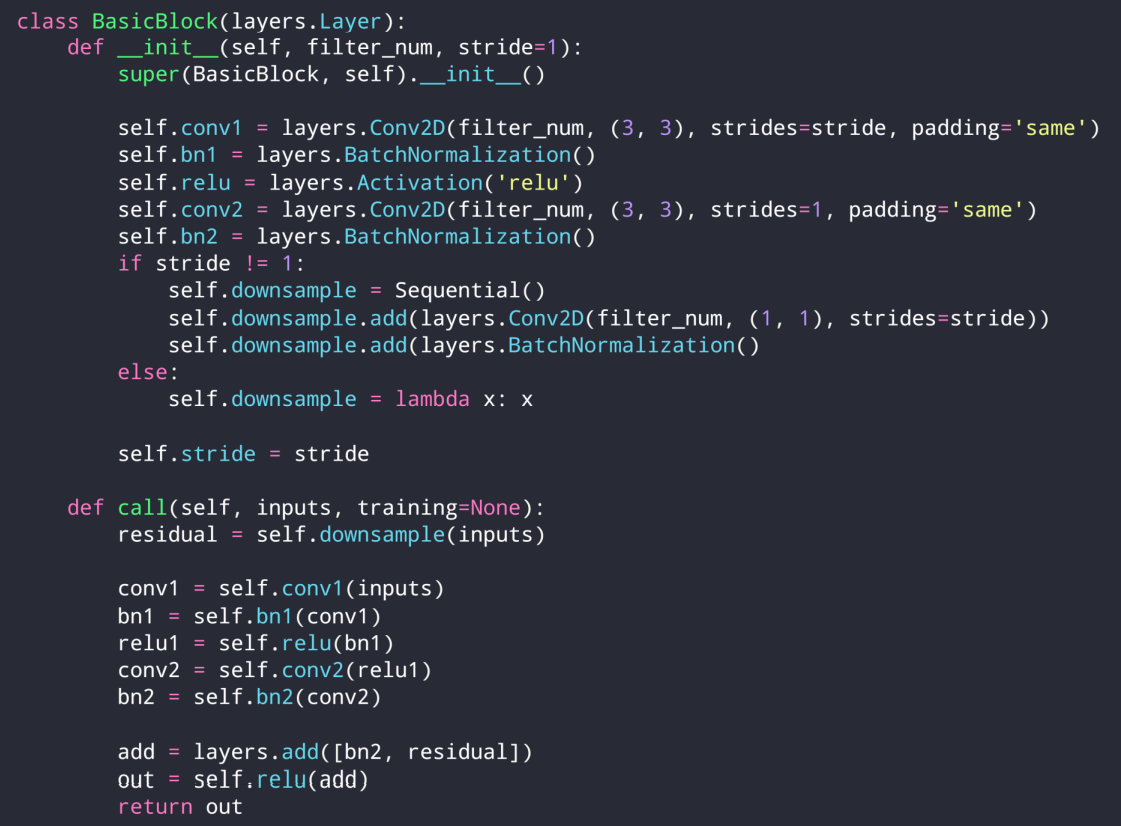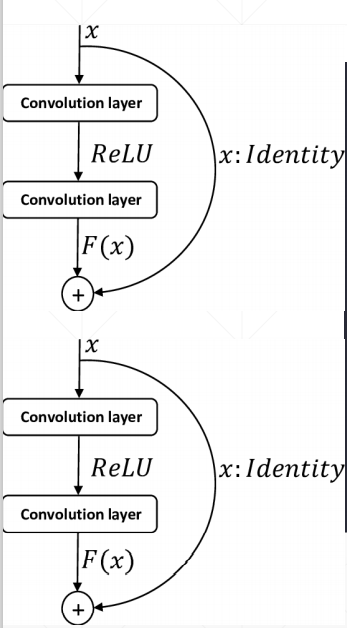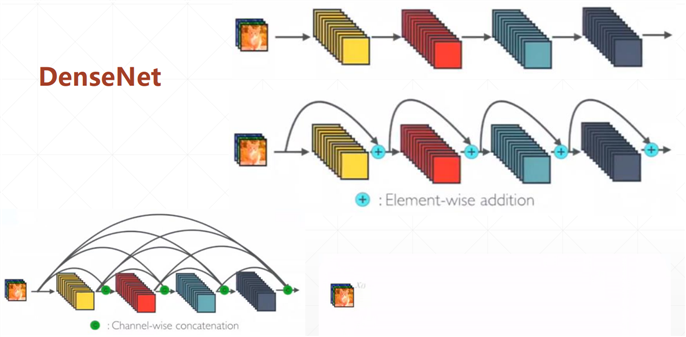标签:cat apply imp equal conv2 ase from mic seq






import tensorflow as tf from tensorflow import keras from tensorflow.keras import layers, Sequential class BasicBlock(layers.Layer): def __init__(self, filter_num, stride=1): super(BasicBlock, self).__init__() self.conv1 = layers.Conv2D(filter_num, (3, 3), strides=stride, padding=‘same‘) self.bn1 = layers.BatchNormalization() self.relu = layers.Activation(‘relu‘) self.conv2 = layers.Conv2D(filter_num, (3, 3), strides=1, padding=‘same‘) self.bn2 = layers.BatchNormalization() if stride != 1: self.downsample = Sequential() self.downsample.add(layers.Conv2D(filter_num, (1, 1), strides=stride)) else: self.downsample = lambda x:x def call(self, inputs, training=None): # [b, h, w, c] out = self.conv1(inputs) out = self.bn1(out,training=training) out = self.relu(out) out = self.conv2(out) out = self.bn2(out,training=training) identity = self.downsample(inputs) output = layers.add([out, identity]) output = tf.nn.relu(output) return output class ResNet(keras.Model): def __init__(self, layer_dims, num_classes=100): # [2, 2, 2, 2] super(ResNet, self).__init__() self.stem = Sequential([layers.Conv2D(64, (3, 3), strides=(1, 1)), layers.BatchNormalization(), layers.Activation(‘relu‘), layers.MaxPool2D(pool_size=(2, 2), strides=(1, 1), padding=‘same‘) ]) self.layer1 = self.build_resblock(64, layer_dims[0]) self.layer2 = self.build_resblock(128, layer_dims[1], stride=2) self.layer3 = self.build_resblock(256, layer_dims[2], stride=2) self.layer4 = self.build_resblock(512, layer_dims[3], stride=2) # output: [b, 512, h, w], self.avgpool = layers.GlobalAveragePooling2D() self.fc = layers.Dense(num_classes) def call(self, inputs, training=None): x = self.stem(inputs,training=training) x = self.layer1(x,training=training) x = self.layer2(x,training=training) x = self.layer3(x,training=training) x = self.layer4(x,training=training) # [b, c] x = self.avgpool(x) # [b, 100] x = self.fc(x) return x def build_resblock(self, filter_num, blocks, stride=1): res_blocks = Sequential() # may down sample res_blocks.add(BasicBlock(filter_num, stride)) for _ in range(1, blocks): res_blocks.add(BasicBlock(filter_num, stride=1)) return res_blocks def resnet18(): return ResNet([2, 2, 2, 2]) def resnet34(): return ResNet([3, 4, 6, 3])
import os os.environ[‘TF_CPP_MIN_LOG_LEVEL‘]=‘2‘ import tensorflow as tf from tensorflow.keras import layers, optimizers, datasets, Sequential from resnet import resnet18 tf.random.set_seed(2345) def preprocess(x, y): # [-1~1] x = tf.cast(x, dtype=tf.float32) / 255. - 0.5 y = tf.cast(y, dtype=tf.int32) return x,y (x,y), (x_test, y_test) = datasets.cifar100.load_data() y = tf.squeeze(y, axis=1) y_test = tf.squeeze(y_test, axis=1) print(x.shape, y.shape, x_test.shape, y_test.shape) train_db = tf.data.Dataset.from_tensor_slices((x,y)) train_db = train_db.shuffle(1000).map(preprocess).batch(512) test_db = tf.data.Dataset.from_tensor_slices((x_test,y_test)) test_db = test_db.map(preprocess).batch(512) sample = next(iter(train_db)) print(‘sample:‘, sample[0].shape, sample[1].shape, tf.reduce_min(sample[0]), tf.reduce_max(sample[0])) def main(): # [b, 32, 32, 3] => [b, 1, 1, 512] model = resnet18() model.build(input_shape=(None, 32, 32, 3)) model.summary() optimizer = optimizers.Adam(lr=1e-3) for epoch in range(500): for step, (x,y) in enumerate(train_db): with tf.GradientTape() as tape: # [b, 32, 32, 3] => [b, 100] logits = model(x,training=True) # [b] => [b, 100] y_onehot = tf.one_hot(y, depth=100) # compute loss loss = tf.losses.categorical_crossentropy(y_onehot, logits, from_logits=True) loss = tf.reduce_mean(loss) grads = tape.gradient(loss, model.trainable_variables) optimizer.apply_gradients(zip(grads, model.trainable_variables)) if step %50 == 0: print(epoch, step, ‘loss:‘, float(loss)) total_num = 0 total_correct = 0 for x,y in test_db: logits = model(x,training=False) prob = tf.nn.softmax(logits, axis=1) pred = tf.argmax(prob, axis=1) pred = tf.cast(pred, dtype=tf.int32) correct = tf.cast(tf.equal(pred, y), dtype=tf.int32) correct = tf.reduce_sum(correct) total_num += x.shape[0] total_correct += int(correct) acc = total_correct / total_num print(epoch, ‘acc:‘, acc) if __name__ == ‘__main__‘: main()
tensorflow(三十九):实战——深度残差网络ResNet18
标签:cat apply imp equal conv2 ase from mic seq
原文地址:https://www.cnblogs.com/zhangxianrong/p/14725992.html